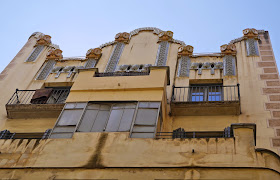A window in the Casa Masó
The historic city of Girona also turns out to have a rich heritage of art nouveau buildings, especially by Raphael Masó (1880-1935). In Catalonia this architectural style is known as Modernisme (not to be confused with the postwar vogue for Modernism) or Noucentisme. It was influenced of course by Gaudi, that most individualistic or architects, but has many common elements with the wider art nouveau movement elsewhere in Europe. Masó's career extended into the 1920s and 30s, so not all his work can usefully be seen as art nouveau. I found this walk hidden away on the website of the Masó Foundation: here is the link.
The official walk starts, reasonably enough, from the Casa Masó, converted by the architect into his family home in 1912, but coming from our hotel on the left bank of the Onyar we first encountered the Bloc Cots on Carrer de Santa Anna, which dates from the 1920s, and is obviously not art nouveau. The decorated panels and the ceramic tiles under the overhanging roof turn out to be typical of Masó's later style.
Next door, however, was a much more art nouveau building with floral motifs over the windows and used as capitals on the columns which separate the windows.
We now crossed the bridge across the Onyar and noted the river frontage of the Casa Masó, the white building in the centre of the picture. The exterior blinds dominate the view, but the ochre coloured tiles are a delight.
Immediately on crossing the bridge, the Pharmacia Masó-Puig is found on the left. You enter through the original pharmacy - a conversion for Rafael's brother Joan, who was a pharmacist - and notice to the left a modern chemist's shop. The facade has been altered since the conversion in 1908, but the old pharmacy has a wealth of original wrought iron shelves, ceramic tiles and light fittings, like the one below.
The Casa Masó is round the corner in Carrer Bellesteries. You only visit on a pre-booked tour. We were lucky enough to find one in French starting within 20 minutes. It was originally four workers' houses which Masó converted into a single dwelling on the occasion of his marriage in 1912. These are some of the wonderful tiles in the entrance hall. We learned from our guide that each one has some family significance.
The first floor hall is especially impressive. The glass in the doors to left is pure art nouveau, while the area to the right seems to show a debt to Charles Rennie Mackinosh. The house was an absolute delight, with beautiful glass, tiles and decorations throughout.
We looked next at another Masó building, te Bloc Ribas Crehuet in Carrer de la Forca, nearby. This five storey building of 1927-8 had to be fitted into a gap between older buildings and did not allow much scope for architectural exuberance. There was another decorative panel as the main ornamentation.
We now headed along the Rambla de la Libertat where I had spotted this marvellous building: the Casa Norat of 1912-13. It was the work of Joan Roca i Pinet. The ground floor curves and oriel window are just fantastic.
Almost opposite was this building with beautiful green nouveau-style decoration.
Returning to the Masó trail, we came to Bloc Salleti (1914-15) in Carrer de al Neu. This was a block of apartments for rent. Tiles are used as the main decorative element: plain straw coloured ones alternate with spiral-decorated "nipple" ones to produce a pleasing and original effect. I wish now I had taken a close up!
Now we crossed the river and walked along Carrer de Neu to find the Casa Battlle on a corner on the left. The lower part of the building is much altered, but the upper part retains powerful ceramic decoration featuring stylised yellow owls. The walk booklet suggests that Masó was influenced in this choice by the Austrian Secession. We saw the Secession building in a walk around Vienna a couple of years ago and there is a definite resemblance.
Crossing Grab Via Jaume 1 you come to the Placa del Marques de Camps and the Casa de Corominas of 1927-8. This was another alteration to an existing building. The stained glass and green floral decoration seemed to be quite art nouveau in feeling, despite the late date.
Nearby is the Casa Gispert Sauch of 1921-3, of no clear style but only blue tiles and an unusual corner balcony.
Conditions: hot and sunny.
Distance: a couple of miles, including the return leg.
Rating: four stars. The Museum was a delight and some of Masó's buildings are impressive. My favourite however was the Casa Norat.













No comments:
Post a Comment